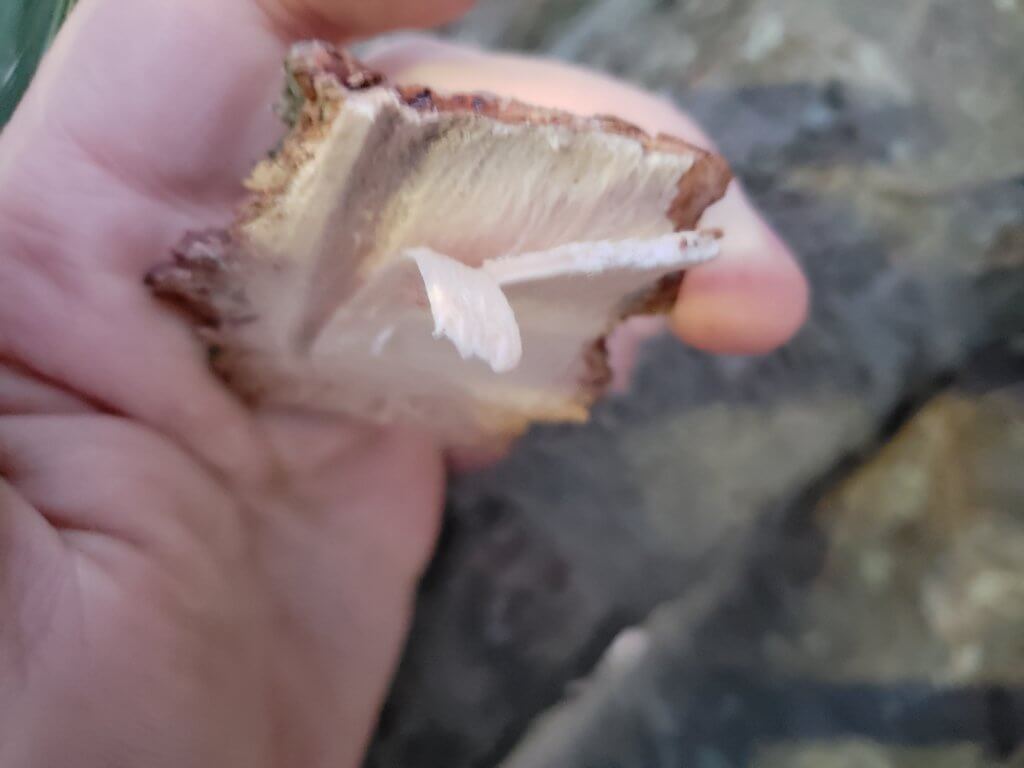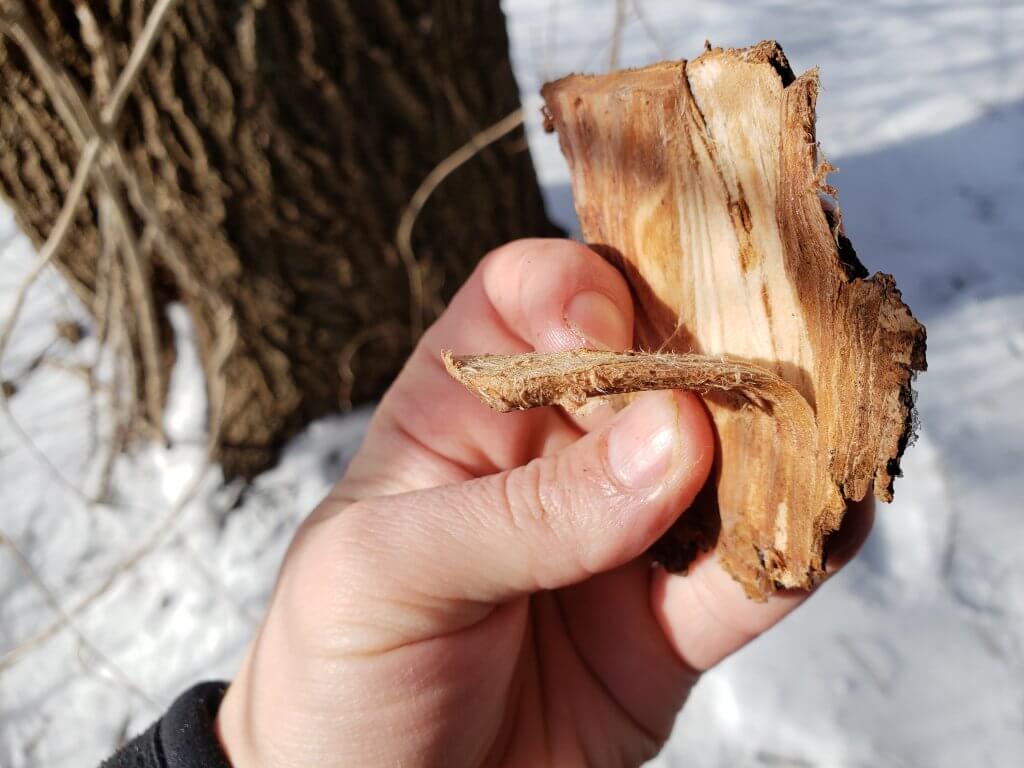Eating the inner bark of certain trees is something that is often referred to as a “good” source of food in survival situations, especially in the winter when not much else is available. I wanted to investigate this claim so I made a list of 5 of the most common trees in the northeastern US that have edible inner bark. I sampled each of these trees as well as putting together a video to go along with this article.

Sampling the bark was a little difficult because I had to only do this on trees or large branches that were going to die anyway. The reason for this is because the most substantial source of inner bark is lower on the trunk and cutting this part of the tree can damage all portions of the tree above it. There were 2 main characteristics I was looking for. The first is the taste of the inner bark, I wanted to see if it was reasonable for someone to consume a large amount of it. The second thing I considered was the amount of inner bark and ease of harvesting. I wanted to be able to get more information on the sugar and starch content, this is what would contain needed calories in a survival situation. It is casually mentioned in a few places online that inner tree bark contains 500-1000 calories per pound but I did not find verified sources with this information for each tree. Although while I was eating the inner bark I did try to notice weather the inner bark seemed to be mostly fiberous or if I tasted sugars and starches while I was eating it. The inner bark layer of a tree overlaps with the phloem on the tree, the phloem carries nutrients up and down the trunk from roots to leaves in the spring and from leaves to roots in the summer and fall so it makes sense that some of these sugars and starches would remain in this part of the tree over the winter. In this article I have arranged these trees in order from worst to best in my opinion based on the feasibility of eating a substantial amount of the inner bark.
This is the related video showing much of the things that are talked about in this article.
5. Eastern Hemlock(Tsuga canadensis)
I wanted to test out eastern hemlock because it is a common native forest tree in my area. The needles make a great tea so I assumed the inner bark would be tolerable. Based on my experience the inner bark is not tolerable. It tasted awful, and it was very bitter. This is a tree that I would recommend for tea but I found almost no use for the edible inner bark. I couldn’t consume enough inner bark to be able to judge weather it seemed to have starch or sugar. That being said it is possible that processing the inner bark more could make it palatable. For example drying, grinding and mixing with flour or boiling it in changes of water might work.
4. Spruce(Genus:Picea)
This tree has many edible uses, such as the resin, the immature cones, and the new growth in the spring. The inner bark layer on spruce trees is thick and soft which makes it relatively easy to harvest. The taste is strong but It’s something you could eventually get used to. I would consider this a good option for edible inner bark, but not the best mainly based on the strong flavor. After chewing the inner bark it seems that this tree does have a substantial amount of sugars and starches. It doesn’t taste sweet, but it’s a lot less fiberous than I expected, the material does eventually break down in your mouth and become easy to consume.
3. Black Birch(Betula lenta)
The good part about the edible inner bark on this tree is that the flavor is pleasant. Black birch is known for it’s “wintergreen” fragrance and flavor that is used in birch beer. The downside of using this tree for it’s edible inner bark is that unlike the other trees on this list birch inner bark is not soft, its rather dry and grainy, kinda like eating sawdust and it’s difficult to separate from the outerbark. I ate it raw by itself but I have heard that it makes a very good option when adding to other things such as dried grains or soup. Birch inner bark is known to contain a substantial amount of calories but probably not as much as spruce, pine, and elm. I don’t know definitively but I assume similar properties for other trees in this genus.
2. Pine(Genus: Pinus)

The pine tree is well known as a tree with edible inner bark. The biggest downside is the strong flavor but it’s easier to get used to then spruce in my opinion. The inner bark is thick and easy to harvest. The species that I sampled and featured in the video is white pine(Pinus strobus) but I assume similar properties for other members of the genus. Some pines may contain minor toxins so check with a website like www.pfaf.org or another trusted site before consuming any specific species. White pine is extremely common in New England and many other parts of the country so it’s very useful to know the edibility of this species. I could definitely feel that I was eating something other than wood fibers, the chewyness and resin content of the inner bark leads me to believe that there is a substantial amount of calories in white pine inner bark.
1. Elm Tree(Genus: Ulmus)

I’m really excited to share this information about the elm tree. This was a completely pleasant surprise for me. I had known that elm trees have been used as a mucilaginous soothing agent but I hadn’t previously realized that the inner bark was edible. I sampled the siberian elm(Ulmus pumila) but I have read similar properties for other elms as well. The taste of the inner bark was very pleasant, it was even a little sweet with no bitterness or bad aftertaste. This plant is known to contain mucilage in the inner bark, this is a thickening agent that creates a gelatinous substance when added to water. So eating the inner bark of the elm does create a gelatinous substance which could be weird or offputting for some people. Its hard to say what the calorie content is but I did taste some sweetness which might indicate a significant level of sugars.
Conclusion
Based on my experiences with these tree species It does seem that the edible inner bark of certain trees can give some needed calories in a survival situation. If you completely debark a tree as high as you can reach you would be able to obtain a lot of edible material with some calories. This would probably not be a good long term survival plan but the inner bark could definitely be added to other wild edibles to give a more balanced diet. If You’re relying solely on inner bark You would still probably want to get some meat or get out of your situation as soon as possible. Another thing that makes edible inner bark a good survival food for the short term is that you can carry it easily without worrying about spoilage even in hot or cold weather. Something else that I also took away from this is that eating certain inner barks like white pine and elm is actually a good food for all situations, not just survival situations. I’ve learned to add fallen logs and trees to my list of things to look for when foraging. I feel there is still much more for the wider foraging community to learn about how to find substantial calorie sources in the winter. If you have any experience with edible inner bark please leave a comment and share any info you have.
Many of our readers find that subscribing to Eat The Planet is the best way to make sure they don't miss any of our valuable information about wild edibles.
See our privacy policy for more information about ads on this site







6 Responses
The inner bark of the common poplar is edible and tastes sweet. From what I’ve read it was used as a survival food by some First People groups in the eastern part of the United States.
I wonder what species that refers to. I tried tuliptree once and it did not taste good although I have heard that some poplar species inner bark is edible. Thanks for the info.
I tried eating inner bark of Eastern White Pine of a live branch that broke off from snow. I found some soft inner bark despite the branch probably not being the best source. The taste was very piney which is a flavour that I found nice and “Christmasy” from needles of the same tree in tea. The flavour was a bit strong in the bark though not overpowering enough to render inedible. I read that cooking on a rock next to a fire or frying in a pan is the best way to prepare it. I would love to experiment more if it did not mean hurting the trees.
thanks for the info. I agree with you exactly on the taste now, although the first time I ever tried it I though it was too strong and inedible. I then came to like it a little more each time I tried it. I too do need to experiment more with cooking it.
I have read books on how the North American First Nations People separated the inner bark, boiled it, ground it and used it as a flour. This might be your way of dealing with its taste.
Have heard about how the Russians, during the World War 2 attack, used tree bark as a means to survive the Nazis blocking their inputs. They had plenty of water (I.e. snow). Thankfully they knew this hack to have food. Have also heard of the Native Americans using inner bark for bread, food, medicine, and to smoke. Look up Slippery Elm or Bois’ de Arc inner bark on “Eat the planet.com”; interesting reading. There are some smoke mixes with Elm and Mullein that are meant to heal the lungs.